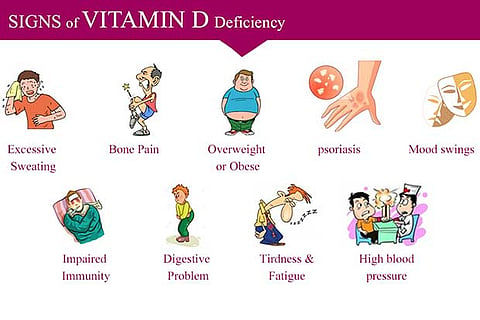

Chennai
A 2019 pan-India study has found that Vitamin D deficiency was significantly associated with Type 2 diabetes and hypertension. The study authored by PG Talwalkar, Vaishali Deshmukh, M C Deepak and Dinesh Agrawal shows that 84.2 percent of Type 2 diabetes patients and 82.6 percent of hypertension patients were Vitamin D deficient. This important India-specific finding further confirms the body of research that links Vitamin D deficiency to chronic diseases.
In India, multiple studies have estimated that Vitamin D deficiency is mostly between 70 to 90 percent of the population, especially during winter. Moreover, studies show there is no significant variation in deficiency levels across North, South, East or West regions, with each reporting deficiency prevalence of 88 percent, 90 percent, 93 percent and 91 percent respectively.
Vitamin D is a critical micronutrient that helps regulate the amount of calcium and phosphorus in the body which helps keep bones, teeth and muscles healthy and overall health. The deficiency is associated with cardiovascular disease, diabetes, cancer and infectious diseases such as tuberculosis.
Though Vitamin D can be synthesized endogenously i.e., produced entirely by the body with adequate exposure to sunlight, it remains the most under-diagnosed and under-treated nutrient deficiency in the world. The causes of Vitamin D deficiency in a sun-drenched country like India are manifold. Most people do not receive adequate exposure to sunlight, as modernized lifestyles have resulted in less time spent outdoors for work or leisure. Moreover, high levels of air pollution can hamper the transmission of
UVB rays is required to synthesize Vitamin D in the skin but many avoid exposure to sunlight during noon hours when it is most beneficial. Further, consumption of vegetarian food has decreased the need for Vitamin D rich foods like cod liver oil, salmon fish, mackerel, sardines, tuna, egg yolk and mushrooms. In the case of poverty driven families, it is even worse. The consequences of deficiency issignificant, especially in children and adolescents where Vitamin D intake is necessary to increase the bone mass.
The overall prevalence of patients with low Vitamin D levels (deficiency and insufficiency) was 83.7 percent. Out of this, 82 percent were newly diagnosed cases. This high prevalence of Vitamin D deficiency in newly diagnosed cases indicates that Vitamin D deficiency may have been missed in a large proportion of patients with Type 2 diabetes, hypertension, or both conditions.
Dr PG Talwalkar of Talwalkar Diabetes Clinic observed, “More than 84 percent of Type 2 diabetes are Vitamin D deficient, as were 82 percent of hypertension patients. A study investigated co-occurrence of deficiency with hypothyroidism and obesity or overweight condition. A lot of hypothyroid patients had low levels of vitamin D, with 82 percent patients being obese or overweight, which calls for routine screening to ensure early diagnosis and effective management of Vitamin D deficiency to reduce the risks associated with NCD.” He added that over 60,000 IU is administered weekly for 8 weeks taking in the patient’s age, development stage, pregnancy and seasonal variations into account. Once sufficiency is restored, sunlight exposure for 30 to 45 minutes around noon hours, a diet rich in Vitamin D and calcium as well as supplementation, depending on patient compliance and circumstances.
In addition to intake ofVitamin D, ensuring its optimal absorption by the body can help increase sufficiency. Innovation in delivery formats can play an important role. Children with low bone mineral density can suffer from skeletal deformities known as rickets.
Dr Srirupa Das, Medical Director, Abbott, explained, “Indian pregnant women have up to 84 percent of deficiency, which correlates in their new-borns. Children of mothers with suboptimal Vitamin D are at risk of reduced prenatal and postnatal skeletal development, which affects both height and bone-health.”
In adults, the Vitamin Ddeficiency is associated with low bone mass and muscle weakness, which results in increased risk of fractures and bone disorders such as osteomalacia, osteopenia and osteoporosis which links to chronic disease.
Visit news.dtnext.in to explore our interactive epaper!
Download the DT Next app for more exciting features!
Click here for iOS
Click here for Android